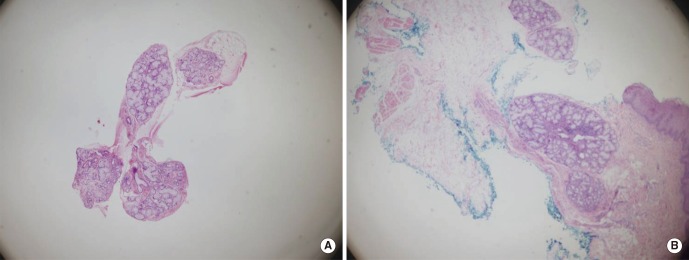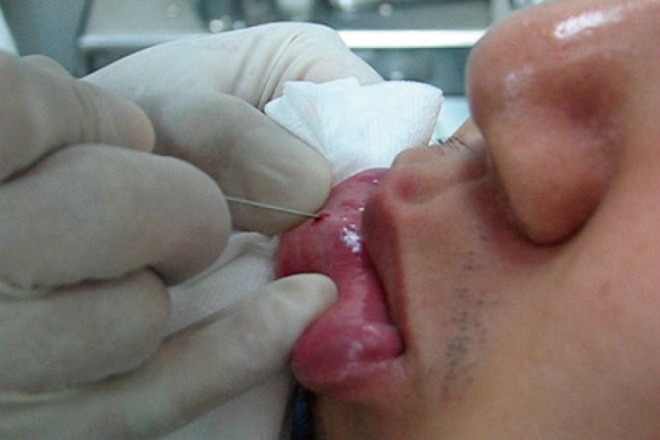1. Jonsson R, Haga HJ, Gordon TP. Current concepts on diagnosis, autoantibodies and therapy in Sjögren's syndrome. Scand J Rheumatol. 2000; 1. 29(6):341–348. PMID:
11132201.
2. Vitali C, Bombardieri S, Moutsopoulos HM, Balestrieri G, Bencivelli W, Bernstein RM, et al. Preliminary criteria for the classification of Sjögren's syndrome: results of a prospective concerted action supported by the European Community. Arthritis Rheum. 1993; 3. 36(3):340–347. PMID:
8452579.

3. Daniels TE. Labial salivary gland biopsy in Sjögren's syndrome: assessment as a diagnostic criterion in 362 suspected cases. Arthritis Rheum. 1984; 2. 27(2):147–156. PMID:
6696772.
4. Pijpe J, Kalk WW, van der, Vissink A, Kluin PM, Roodenburg JL, et al. Parotid gland biopsy compared with labial biopsy in the diagnosis of patients with primary Sjögren's syndrome. Rheumatology (Oxford). 2007; 2. 46(2):335–341. PMID:
16891656.
5. Vitali C, Bombardieri S, Jonsson R, Moutsopoulos HM, Alexander EL, Carsons SE, et al. Classification criteria for Sjögren's syndrome: a revised version of the European criteria proposed by the American-European Consensus Group. Ann Rheum Dis. 2002; 6. 61(6):554–558. PMID:
12006334.
6. Vitali C, Bombardieri S, Moutsopoulos HM, Coll J, Gerli R, Hatron PY, et al. Assessment of the European classification criteria for Sjögren's syndrome in a series of clinically defined cases: results of a prospective multicentre study. The European Study Group on Diagnostic Criteria for Sjögren's Syndrome. Ann Rheum Dis. 1996; 2. 55(2):116–121. PMID:
8712861.
7. Calman HI, Reifman S. Sjögren's syndrome: report of a case. Oral Surg Oral Med Oral Pathol. 1966; 2. 21(2):158–162. PMID:
5215974.
8. Cifarelli PS, Bennett MJ, Zaino EC. Sjogren's syndrome: a case report with an additional diagnostic aid. Arch Intern Med. 1966; 3. 117(3):429–431. PMID:
5905071.

9. Chisholm DM, Mason DK. Labial salivary gland biopsy in Sjögren's disease. J Clin Pathol. 1968; 9. 21(5):656–660. PMID:
5697370.
10. Berquin K, Mahy P, Weynand B, Reychler H. Accessory or sublingual salivary gland biopsy to assess systemic disease: a comparative retrospective study. Eur Arch Otorhinolaryngol. 2006; 3. 263(3):233–236. PMID:
16378222.

11. Liquidato BM, Soler Rde C, Bussoloti Filho I. Evaluation of the concordance of sialometry and salivary glands scintigraphy in dry mouth patients. Braz J Otorhinolaryngol. 2006; Jan-Feb. 72(1):116–119. PMID:
16917562.

12. Teppo H, Revonta M. A follow-up study of minimally invasive lip biopsy in the diagnosis of Sjögren's syndrome. Clin Rheumatol. 2007; 7. 26(7):1099–1103. PMID:
17522950.

13. Delgado WA, Mosqueda A. A highly sensitive method for diagnosis of secondary amyloidosis by labial salivary gland biopsy. J Oral Pathol Med. 1989; 5. 18(5):310–314. PMID:
2769600.

14. Greenspan JS, Daniels TE, Talal N, Sylvester RA. The histopathology of Sjögren's syndrome in labial salivary gland biopsies. Oral Surg Oral Med Oral Pathol. 1974; 2. 37(2):217–229. PMID:
4589360.

15. Friedman H, Kilmar V, Galletta VP, Cossermelli W. Lip biopsy in connective tissue diseases: a review and study of seventy cases. Oral Surg Oral Med Oral Pathol. 1979; 3. 47(3):256–262. PMID:
84370.
16. Smith SR, Shneider BL, Magid M, Martin G, Rothschild M. Minor salivary gland biopsy in neonatal hemochromatosis. Arch Otolaryngol Head Neck Surg. 2004; 6. 130(6):760–763. PMID:
15210559.

17. Guevara-Gutiérrez E, Tlacuilo-Parra A, Minjares-Padilla LM. Minor salivary gland punch biopsy for evaluation of Sjögren's syndrome. J Clin Rheumatol. 2001; 12. 7(6):401–402. PMID:
17039183.

18. Gorson KC, Ropper AH. Positive salivary gland biopsy, Sjögren syndrome, and neuropathy: clinical implications. Muscle Nerve. 2003; 11. 28(5):553–560. PMID:
14571456.

19. Fox PC. Simplified biopsy technique for labial minor salivary glands. Plast Reconstr Surg. 1985; 4. 75(4):592–593. PMID:
3983264.

20. Peloro TM, Ramsey ML, Marks VJ. Surgical pearl: "X" marks the spot for the salivary gland biopsy. J Am Acad Dermatol. 2001; 7. 45(1):122–123. PMID:
11423846.

21. Seoane J, Varela-Centelles PI, Diz-Dios P, Romero M. Use of chalazion forceps to ease biopsy of minor salivary glands. Laryngoscope. 2000; 3. 110(3 Pt 1):486–487. PMID:
10718443.

22. Mahlstedt K, Ussmuller J, Donath K. Value of minor salivary gland biopsy in diagnosing Sjögren's syndrome. J Otolaryngol. 2002; 10. 31(5):299–303. PMID:
12512895.






 PDF
PDF Citation
Citation Print
Print





 XML Download
XML Download